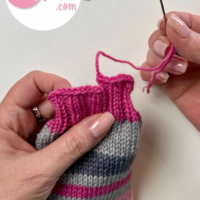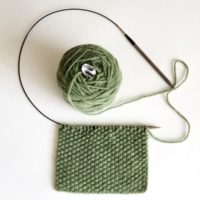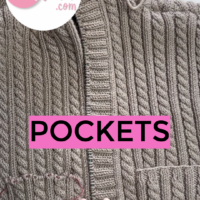
The Log Cabin Scrap Blanket pattern and video tutorial can be found here.
I noticed that I’m getting many of the same questions on this pattern, I believe it deserves it’s own FAQ page.
GENERAL QUESTIONS
Q: What is a garter stitch ridge? How many rows make a ridge?
A: It is easier to count garter stitch ridges in this pattern, rather than rows of knitting. You can see the ridges in your work, and I demonstrate in the video. A garter stitch ridge is made up of two rows of knitting, a right-side and a wrong-side. In your center square, the cast-on creates one-half of a ridge – so the cast-on plus the next row of knitting creates one ridge. On subsequent strips, picking up stitches creates one-half of a ridge – so the picked up stitches plus the next row of knitting creates one ridge. Really, it’s much easier just to count the ridges you see, rather than counting rows and trying to convert them to a number of ridges.
Q: I can’t seem to get the colors of my blanket to come out as nicely as yours. What am I doing wrong?
A: My guess is that you’re doing it correctly. 🙂 Don’t get hung up on the colors of any one square. Once the whole blanket comes together, the colors take on a different personality. I followed three simple rules in regards to color – first, I made sure that no single square was dominated by a single color. Second, I made sure that no single square was dominated by mostly dark or mostly light colors. Third, I kept really uncomplimentary colors from touching each other. That’s it!
Q: I don’t understand how to work the borders.
A: The borders are worked like every other strip. The only difference is that you’re not cutting the yarn to start a new color. Just stick with the same border color for four strips, which will cover each of the four sides.
Q: My worsted weight yarn leftovers vary in thickness. Is that okay?
A: In the blanket pictured above, mine varied, too. I would guess that the yarns I used could be called worsted, light worsted, and Aran. It turned out fine.
MODIFICATIONS
Note – I provide a ton of information below about modifying this pattern. Please understand that questions beyond what I’ve answered here will take some experimenting and test knitting on your own. Your yarn/needles/gauge are unique to your blanket, so I can’t really answer specific questions. I hope the info below gets you started so you can pull out your yarn and needles, do a little math, and make your quilt blocks exactly how you imagine them. Good luck!
Q: I’d like to buy yarn and coordinate colors, instead of using leftovers for this project. How much yarn do I need?
A: That will depend on how you want to arrange the colors. In the pattern, I have a graphic that shows each strip and how it fits into the square. Plan your colors out as you want them for each strip, then do the math –
- Center square – about 20 yards of yarn
- Strip 1 – about 10 yards
- Strip 2 – about 15 yards
- Strip 3 – about 15 yards
- Strip 4 – about 20 yards
- Strip 5 – about 20 yards
- Strip 6 – about 25 yards
- Strip 7 – about 25 yards
- Strip 8 – about 30 yards
This is a guideline for the weight of yarn I used (worsted), with the gauge listed in the pattern (5 stitches per inch).
Q: I don’t have enough worsted scrap yarn to make the whole blanket, so I’d like to mix it up and use different weights of yarn in my blanket. Will this work if I change needle sizes based on each yarn weight to adjust the gauge for each strip?
A: In theory, this will work, yes. But do you want to swatch for gauge for each strip you knit? Not only would that be a lot of extra work, but it is unlikely that your blanket will end up with straight, right angles. I recommend making this a longer-term project, and using one weight of scrap yarn (I used worsted) as you accumulate more leftovers as time goes by.
Q: I don’t have enough of one fiber type (animal, plant, synthetic) to make the whole blanket. Can I mix it up?
A: I address this in the video tutorial – I don’t recommend it. Not only will you end up with a blanket with no clear washing instructions, but different fiber types are going to behave differently when they are met with water or steam. You may end up with some strips that end up sagging and loose (like cotton), while other strips hold their shape. I recommend making this a longer-term project, and using one fiber type (I used animal) as you accumulate more leftovers as time goes by.
Q: I’d like to make one big quilt block, so that I don’t have to do any seaming. Is this possible?
A: Yes! You can absolutely keep adding strips to make a bigger blanket. Just keep this in mind – you’re going to need greater and greater yardage for each strip as the blanket grows. I personally would not be able to make a scrap blanket this way, since my leftovers are only in small amounts.
Q: I’d like to make bigger/smaller quilt squares using a different yarn. How much border color will I need?
A: You will need to test this out yourself, here’s how you do it – knit up one square in the size you want it. Using a new skein of yarn (you need to know exactly how many yards and grams there are, so this cannot be scrap yarn), knit the border, then weigh what remains of that skein on a kitchen scale. Subtract the new weight from the original weight (printed on the ball band) to see how many grams of yarn you used. Then do some math –
X = the number of grams per yard for that yarn
Original weight of skein – new weight of skein = Y
Y = the number of grams used in the border
X * Y = number of yards needed for the border on each square
Q: Can I hold a lighter weight yarn double-stranded to get the same weight as worsted?
A: You’ll need to test this out yourself, but if the gauge is about the same, it should work fine next to worsted yarns in the blanket.
Q: I would like to make a bigger/smaller blanket. How many quilt blocks should I make?
A: My suggestion is to knit up one quilt block using the yarn and needles you’d like to use, then make a judgement. Baby blankets are typically about 40×40 inches, king-sized bedspreads are typically about 90×90 inches, and there are lots of useful blankets in-between those two. You can decide how many quilt blocks to make once you see the exact size you get after knitting one up.
BLOCKING
Q: Do I have to steam block each square?
A: You will find it easier to seam the finished squares together if you steam them before seaming. I steam stuff out all the time while I’m knitting it – mainly because I like the look of it. Steaming as you go will also alert you to any tension problems you might be having with the strips, like a tight bind-off.
Q: Should I wet block the entire blanket when it’s finished?
A: This is up to you. I chose not to wet block my finished blanket, and I probably won’t ever do that unless something gets spilled on it. I used wool for mine, and wool doesn’t need washing as much as other fibers. Instead of washing, I will put the dry blanket into the dryer with a dryer sheet to freshen it up. Additionally, my dryer sheets are scented with lavender, which is supposed to keep moths away!





Wow!! You are amazing! Thanks so much for the super quick response. Your suggestion worked perfectly. I think it has something to do with the number of ridges… I get 10 full ridges but I end up on the wrong end (opposite side from where I started the strip) and then I go back across to be able to BO so it it ends up in the right corner and when complete, it’s like I have an 11th ridge. Anyway – I am consistent, maybe consistently wrong, but it seems to be working out.
Thank you again Staci.
Mary
Hello Staci
I adore this blanket, looking forward to using it for my stash
Can you confirm that the caston row is considered the first part of the ‘first ridge’, meaning the caston row and subsequent row together make 1 ridge? In the past I have not considered hte caston row as my first row of knitting but recent articles I have read indicate it should
Thanks alot
Rachel
Rachel – yes. The beginning square of this pattern is 20 garter stitch ridges, which is 40 rows. But the cast-on will create the first half of the first ridge, making it actually 39 rows.
S t a c i
I just finished a blanket of 2×3 blocks of baby weight yarn for my friend’s daughter’s doll blanket. It turned out beautifully. I was reading the comments and was puzzled by the questions about the border rows. I finally figured out that I didn’t read all of the instructions. I did 5 ridge borders on all of the blocks, sewed them together, then picked up stitches across the entire out side edge to finish off the final 5 ridges on the outside blocks (treating the entire blanket as a block). Because of this I didn’t have to figure out position and which blocks needed extra ridges. I did need long circular needles. I plan on doing this with th full size blanket for my grandson too.
Thank you for your tutorials. I’m tackling gloves next.
Candy
I am getting ready to add borders to the blocks. Is there an order to the knitting of the border sides, e.g. top-right,-bottom, opposite sides, etc. so that when seaming them they blend well and the ridges match up?
Hi Barb – there is no order, as in the order in which you should knit them. But there is “order” – in that some edges will have 5 ridges and others 10. It is explained in the pattern and video better than I can explain it here in email/comments!
S t a c i
Staci – I am struggling with picking up the garter stitches. I have watched several different vidoes – and have tried picking up the “front” of the knot, the “back (upper)” loop of the knot, picking up with a DPn from left to right , then knitting the stitch…. No matter what I try, the join looks awful. The picked up cast on and cast off edges look great, it’s just the garter. I am using a fine yarn (Rowan cashsoft DK), after the pickup the stitches looked “stretched”. The only pickup which looks reasonable is where i pick up in the space BETWEEN the knots, rather than trying to pick up the loops of the knot. This looks great on the right side, but gives me a larger “bump” on the wrong side. Help! I have no idea what I am doing wrong… everyone’s blanket look so good in the pics… wish I knew why mine looks so bad… Thanks!
Hi Staci, I love your videos and patterns. I’ve now got a bunch of squares made and my family is thrilled with the way it looks. Thanks for a really fun project!
David
Hi. You are a good teacher. It says in the comments section:
“Q: I’d like to make one big quilt block, so that I don’t have to do any seaming. Is this possible?
A: Yes!”
However I noticed you used circular needles. It appears this is because the bigger the blanket gets, the more stitches you need to keep on the needle. Does this mean I would be unable to make one infinitely large quilt block, or am I missing something?
Thank you
Steve – I always use circular needles, and never use straight needles (except DPNs), just as a personal preference. As long as you can fit all of the stitches on straight needles, you can keep knitting! Eventually your blanket size probably will be limited by the needles.
S t a c i
Hi there. Can you do a crochet border to finish off the squares instead of knitting them?
Hello, What yarn was actually used in the pictured design??? It is lovely.
Maureen – it is better to ask what yarn WASN’T used in my finished blanket! It is all kinds of 100% wool, worsted weight yarns. I know that some of the brands are Cascade 220, Knit Picks Wool of the Andes, and a Berroco yarn that I can’t remember the name of. I’m sure there are at least 10 different yarn brands in there.
S t a c i
Hi Staci, I love your blanket and your tutorial makes it so easy to follow. My question is, o I use the same number of rows and stitches if I am using UK DK weight yarn. thankyou
Hi! I want to make this blanket to use up my scraps of acrylic. But I don’t really care for the look of garter stitch….would it be OK to do this blanket in stockinette?
Noa – the pattern will not work as written in stockinette stitch, as the row gauge is very different from garter stitch. Also, there is a good chance that your blanket won’t lie flat in stockinette.
S t a c i
Hi Staci! I have been knitting less than a year , and I am sure I am way over thinking this ..but how many stitches do you pick up on each side to knit the borders? This was broke down for all the other strips but I dont see it for the borders? Thank you for your videos, without them I would have given up knitting right after I started!
Katie – counting the border stitches will be the same method you’ve been using throughout the whole blanket, in multiples of 10.
S t a c i
Can I crochet border? I finished my blocks and having hard time with border.
Dear Pink, I finished my first square and it turned out fine but it will lay flat as I think my tension was different with each stripe. What now?
I MADE a typo as I meant to say that my square wont lay flat. But you probably figured that out.
You can try applying steam from a steam iron, without pressing down. (This is fine for wool, cotton, or other animal fibers; but probably not okay for acrylics.) You’ll be able to see if the square will lay flat after you apply steam, and straighten the square out.
S t a c i
Hello thank you for sharing your beautiful log cabin pattern.
My issue is with the border strip outside edge. Several of my squares 10 ridge strips are “rippling up” or “bunching up” and I’ve never had a problem with my tension so I don’the know what I could be doing wrong to create this problem. I’m using a worsted weight yarn. I have knitted two other ‘lap’ afghans using your log cabin pattern but without the finished border and neither had this bunching issue. Im picking up every stitch and it only happens with the 10 ridge border strips. 3Thank you for any suggestion to resolve this problem.
hi I am look for the best yarn for this pattern Parcheesi Afghan, what best yarn?
Just wanted to say I am so excited about making this blanket. Thank you! I have found that using my Denise interchangeable set, I can pop off a needle and pop on a crochet hook to pick up the stitches. Much easier! 🙂 In doing this, it seems that the stitches are twisted. I’m thinking I should knit this row thru the back loop. Would this change the look of the pick up row?
Can I use size 9 circulars or straights or a size 5 circular or straights I don’t have a 7
Love this blanket! So excited by this, my first knitting project.
I’m having the same problem as Rachel Steinman with the garter edge pickup. If I use the method you demonstrate so clearly in the videos I end up with a big bumpy seam behind, which doesn’t look attractive. If I pick up (as Rachel also says she’s tried) by using the last stitch in the row, I too get a “stretched” stitch one before it. I’m using a 4mm needle for the project and a 3mm for pickups. I’m considering chain edges as there is so much picking up, but cannot get this working properly either – one edge behaves, the other simply won’t! It would be great if you could do one of your fantastic videos on chain edges.
Hi. I’m starting to make this blanket for my son. I haven’t watched the full video, but I was wondering 1 thing: Is it Okay/safe/recommended to do the slip stitch (slip purlwise, flip and knit) to start every row so that when you start a new strip you’ll have a clean/neat edge to work with? I’m not sure if you have addressed this before. Thanks for any help.
TyTy – sorry, I’m not familiar with that technique. To keep the garter stitch ridges even, I suggest doing it the way its stated in the pattern, and demonstrated in the video.
S t a c i
slip stitch? Where you slip the first stitch of every row purl-wise and then knit straight across, and repeat for every row. It gives the edges a nicer look. I thought it might be easier to see where to stick my needle in when I’m adding a new row bc it makes that V edge kind of like the cast on/ bind off edge. But you recommend just knitting straight across and nothing “fancy”?
TyTy- okay, I thought you were saying something about slipping stitches and turning the work. Yes, slipping stitches is a common way to treat edge stitches. I do not recommend it, especially for this blanket. If you slip the first stitch, you will need to pick up TWO stitches from each slipped stitch, which will leave gaps at the pick-up row.
S t a c i
Ok. Thank you for that info because I was about to try it and worried what would happen. I’ve got one square complete and working on my second one. Maybe by this time next year it will be finished!!
Love this pattern! one question though. When I pick up stitches along the edges, does a thicker ridge appear in the back? I seem to have a thick ridge on the backside, only along the picked up edges.
Thank you for such a fast and precise response. Wow! Only 6 hours from when I sent you a message.
Esther – any time you pick up and knit stitches, it leaves a ridge on the back of the work. The thickness of it depends on the thickness of your yarn, and how far down into the work you’re picking up the stitches.
S t a c i
Hi very pink. I love love love this blanket and your video. I’m very new to knitting so went and bought yarn to make it and am finishing my first block. I’m confused about the border, the first one was easy (pick up 10 stitches in a 20 row etc) but what do u do on the next one? If the first border is 5 rows do u pick up 2 stitches? Or 3? Then last border has two borders at the ends so how many extra is that? Thanks so much x
Cat – the border is worked like every other strip you’ve worked. The only difference is that you are not changing color.
S t a c i